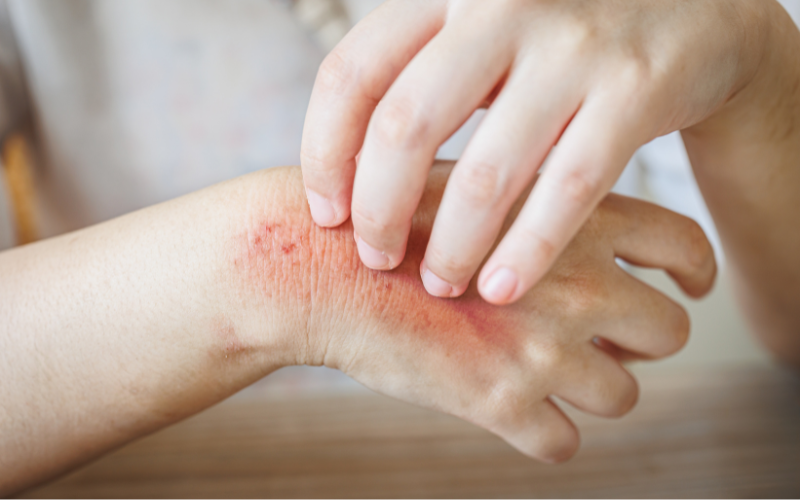
Cord tissue stem cell therapy is showing game-changing promise in a new clinical trial for children with epidermolysis bullosa (EB)—a rare, painful skin disorder that causes severe blistering and tearing. Early results from the MissionEB study suggest that stem cells from umbilical cord tissue may significantly reduce pain, itching, and skin damage in children with the most severe form of EB, offering new hope where few options have existed. [1]
What Is Epidermolysis Bullosa?
EB is a group of rare inherited conditions that make the skin extremely fragile. Even gentle rubbing or slight friction—like clothes brushing against the skin—can cause blisters or painful wounds.[2]
Many children with EB also get blisters inside their mouths or throats, which can make eating difficult. Daily care is often focused on treating wounds, dressing blisters, and trying to manage constant itching without damaging the skin further.[3][4]
EB comes in several types, with recessive dystrophic EB (RDEB) being one of the most serious. Children with this form of EB face a lifetime of painful skin damage and are more likely to develop life-threatening complications like skin cancer or infections.[5][6][7][8]
A Promising New Treatment Using Cord Tissue Stem Cells
A recent clinical study, called MissionEB, tested whether cord tissue stem cell therapy could help treat children with severe RDEB. The trial was run at Great Ormond Street Hospital, one of the UK’s expert centres for EB care.[1][9]
In the past, researchers had seen some improvement using stem cells from bone marrow. This new study used mesenchymal stem cells (MSCs) from cord tissue instead, which may be more effective and easier to collect at birth.[10][11]
The trial involved 30 children. Each child received either the real treatment or a placebo (a fake treatment), and then switched after nine months so that all children had the chance to receive the therapy. Neither families nor doctors knew who was receiving what during the first stage—this helped keep the results fair and unbiased.[11][12]
What the Results Showed
The early findings are very encouraging:
- Children reported less pain and itching, which are some of the most difficult symptoms to live with.
- Some saw improvements in their skin, especially younger children and those with milder forms of the condition.
- Many families were able to tell when their child was receiving the real treatment based on how much better they felt.[1][11]
A follow-up study is now underway, where all the children who took part in the first cord tissue stem cell therapy are receiving more rounds of the treatment over a 12-month period.[1]
Why Saving Cord Tissue at Birth Matters
These exciting results are a powerful reminder of the life-changing potential of stem cells, especially those found in umbilical cord tissue.
While most people have heard about cord blood banking, it’s just as important to know that cord tissue is also an abundant source of mesenchymal stem cells (MSCs)—and other stem cells not found in cord blood. MSCs are being studied in clinical trials like this one, for their ability to reduce inflammation, repair damaged tissues, and support healing in complex diseases like EB.[11]
By saving both cord blood and cord tissue at birth, families are preserving a wider range of stem cells that could be used in future treatments—not just for the baby, but potentially for siblings and other relatives too.
In 2014, we became the first UK cord blood bank to release a cord tissue sample to support treatment for a child with epidermolysis bullosa. It’s just one example of how this small step at birth could make a big difference down the road.
References
[1] Bryson, S. (2025). Epidermolysis Bullosa News. https://epidermolysisbullosanews.com/news/stem-cell-therapy-reduces-itch-pain-rdeb-children-trial/
[2] NHS (2021). https://www.nhs.uk/conditions/epidermolysis-bullosa/treatment/
[3] Bionews Staff (2017). https://epidermolysisbullosanews.com/what-is-epidermolysis-bullosa/
[4] Danial, C., et al. (2014). Pediatric Dermatology. https://doi.org/10.1111/pde.12391
[5] Mellerio, J.E., et al. (2025). Clinical and Experimental Dermatology. https://doi.org/10.1093/ced/llaf009
[6] Soro, L., et al. (2015). Journal of Clinical and Aesthetic Dermatology. https://pmc.ncbi.nlm.nih.gov/articles/PMC4445895/
[7] DEBRA UK. (2024). https://www.debra.org.uk/get-support/eb-support-and-resources/about-eb-debra-uk/dystrophic-epidermolysis-bullosa/
[8] EB Research Partnership. (2025). https://www.ebresearch.org/dystrophic.html
[9] DEBRA UK. (2025). https://www.debra.org.uk/get-support/eb-support-and-resources/eb-professionals/specialist-eb-healthcare/
[10] Petrof, G., et al. (2015). Journal of Investigative Dermatology. https://doi.org/10.1038/jid.2015.158
[11] Cure EB. (2025). https://cure-eb.org/research-portfolio/mission-eb/
[12] ISRCTN. (2025). https://www.isrctn.com/ISRCTN14409785
